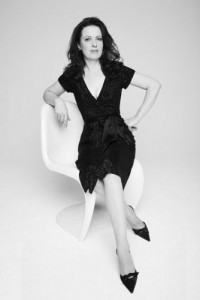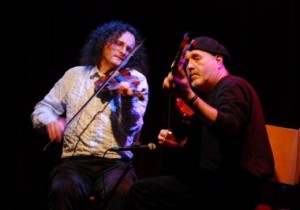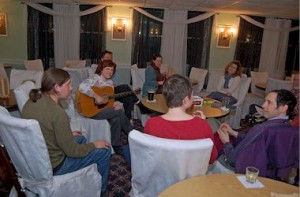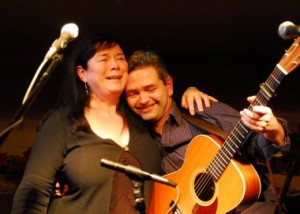Linda Welby is raising eight children, manages holiday cottages, and runs bus tours in her native Connemara (she’s a licensed bus driver!). But don’t hate her because she’s beautiful and makes the Energizer Bunny look like a shirker.
In fact, if you listen to her much-acclaimed debut CD, “A Story to Tell” – yes, she’s a singer-songwriter too—you’re probably going to love her. Just read the lyrics to “The Galway Fiddler,” the first release off the CD, a spirited tribute to buskers.
“He said he had learnt from the birds in the sky
Their songs each morn he’d play till he die
He learnt to listen to the breeze
through the heather
And play to it’s whistling
in all types of weather.”
“I love to stop and listen to them entertain people and it’s many times they have brightened my day,” Linda told me recently. Though she admits she “never expected for a split second that it would take off or that it would even get airplay,” its infectious country sound has even inspired new dance steps In Ireland.
The CD is infused with personal meaning. Her songs are the consummation of a lifetime of writing poems that Linda discovered she had the gift for turning into music “The lyrics come to me first, and my feelings for the words would follow with music,” she says. “When I was working on my album, only then did I discover that I could compose reels, jigs, and hornpipes.”
Music has been a part of Linda’s life since she was born and her dad, Paddy Doorhy, “brought me out to his gigs and showed me to the world. I would sit on his knee while he played the drums and he would use my two hands to drum for him.”
The eldest of five children, and the only one who has taken up music full-time, Linda grew up surrounded by the heritage of rich musical tradition: her grandfather, also Paddy Doorhy, was in the Ballinakill ceili band, the Leitrim ceili band and many others. He was “an amazing fiddle player who could make it talk to you. Very strict when it came to how a tune was played and wouldn’t at all go with the trad ways of playing today. His style of playing would be slower, more relaxed and savored better. He taught me the fiddle–nails had to be short and no nail varnish. I did query the nail varnish…he said he just didn’t like the look of it.”
Linda has performed with the band Cois Tine for 14 years, initially playing the drums, but along the way learning the banjo, tin whistle, accordion, mandolin and the keyboards. In 2003, the group released a CD called “Memories.” Over the years, their musical style changed from the trad sound they started with—as Linda’s vision for the music she wanted to make expanded: “I’m a great lover of the Glen Miller ballroom era and to touch on what I really loved I had to leave the drums behind. We are still Cois Tine, we play three to four nights every week all year round, we do the social dances to the very small pubs…I do the odd concert and guest appearance apart from the band and to see a few hundred people wanting your autograph and queueing to talk to you is a so, so different scene. I have a fight with myself from time to time over where I should be.”
Family continues to be at the core of Linda’s music. “What keeps me passionate is my Dad to make proud which I know he is already,” she says. “My dad is my hero and a huge inspiration to me and I get emotional even saying that. When I wrote the song ‘Dear Dad’ he was so proud of his song, he never stopped playing it and telling everyone ‘that’s my daughter and she wrote that for me.’ My mum was proud of it too, so I felt she had to have a song too and I penned ‘We Love You Mum.’ The jig ‘Port Cait Dan’ is named after my mother Kathleen, Cait being the Irish of Kathleen; Dan is her father. People who’ve grown up in the native Irish-speaking areas were called by their dad’s name after their own to identify the family, ‘port’ is the Irish word for ‘jig’ (‘purt’).”
And she’d never be able to do everything she does without a supportive family. Her husband, she says, always tells her, “you’re better than you think you are.” Her kids, who range from 7-20, are equally helpful. “I have come home on many occasions from a gig to get into a bus and pick up people for tours and be home in time for breakfast and school runs. It can be difficult at the best of times to keep a balance but I’m lucky in the sense that my work is so flexible and it’s all about compromise. I have never had to turn down a gig yet because of my family.”
After listening to Linda’s CD, which can be sampled and purchased at her website, it’s difficult to believe that it wasn’t that long ago, she confesses, that she “couldn’t listen to myself singing at all and I never classed myself as a singer.” She recalls when one recording engineer at the music studio “started to panic when I wouldn’t sing because he was looking at me.”
On the brink of fame, she and her music are still focused on what’s important in life. “I love life,” she says, “and it’s the simplest things I get happiness from like giving or holding the door open for someone that’s strugglin’ with it, and to sit down at dawn and listen to the quietness. I’d give up every material thing I have to hold onto those little things.”






